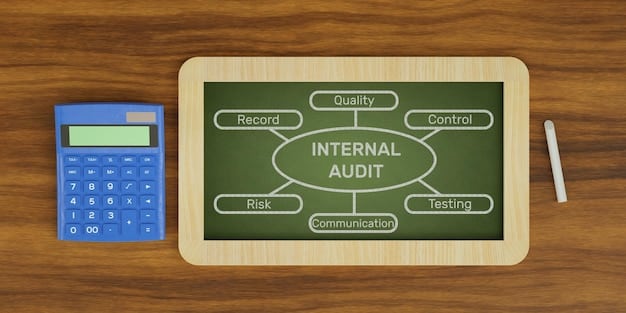Ethics Audit Guide for US Companies in 2025: A Step-by-Step Approach

Conducting an effective ethics audit in 2025 involves a systematic approach, including planning, risk assessment, policy review, data collection, analysis, reporting, and implementation of corrective actions to ensure US companies maintain ethical standards and regulatory compliance.
In today’s complex business landscape, maintaining a strong ethical foundation is crucial for the success and sustainability of any U.S. company. A well-executed ethics audit can help organizations identify potential risks, ensure compliance with regulations, and foster a culture of integrity. This guide provides a step-by-step approach for US companies looking to conduct an effective ethics audit in 2025.
Understanding the Importance of Ethics Audits
Ethics audits are essential tools for US companies in 2025. They provide a structured assessment of an organization’s ethical culture, policies, and practices. Understanding the ‘why’ behind these audits is the first step in ensuring their effectiveness.
What is an Ethics Audit?
An ethics audit is a systematic evaluation designed to identify vulnerabilities, assess risks, and ensure compliance with internal and external ethical standards. It’s more than just a checklist; it’s a comprehensive review of all aspects of an organization’s operations.
Why Conduct an Ethics Audit in 2025?
Several factors drive the need for ethics audits, especially in 2025. Regulatory scrutiny is increasing, stakeholder expectations are evolving, and technological advancements introduce new ethical dilemmas.
- Regulatory Compliance: Stay ahead of legal and regulatory changes.
- Risk Management: Identify and mitigate potential ethical risks.
- Stakeholder Trust: Build and maintain trust with employees, customers, and investors.
- Competitive Advantage: Demonstrate ethical behavior as a competitive differentiator.
In conclusion, understanding the importance of ethics audits enables companies to proactively address risks, foster a culture of integrity, and gain a competitive edge.
Step 1: Planning and Preparation
Effective planning is the cornerstone of a successful ethics audit. Without a clear plan, the audit can quickly become unfocused and ineffective. This phase involves defining the scope, objectives, and resources needed for the audit.

Define the Scope and Objectives
Clearly define what the audit will cover. This includes the areas of the business, specific policies, and ethical risks to be examined. The objectives should be measurable and aligned with the company’s overall ethics and compliance goals.
Assemble the Audit Team
The audit team should include individuals with diverse skills and perspectives. This may include internal compliance officers, legal counsel, HR representatives, and external consultants. Ensure the team has the authority and resources needed to conduct a thorough audit.
- Internal Compliance Officer: Provides expertise on internal policies and procedures.
- Legal Counsel: Ensures compliance with relevant laws and regulations.
- HR Representative: Addresses employee-related ethical issues.
- External Consultant: Offers an objective and unbiased perspective.
Proper planning and preparation are crucial for an ethics audit, providing a solid framework for the subsequent steps and ensuring a more effective and thorough review.
Step 2: Risk Assessment and Identification
Identifying potential ethical risks is a critical part of the ethics audit process. This step involves assessing the vulnerabilities and threats that could compromise the organization’s ethical standards.
Conduct a Risk Assessment
Perform a comprehensive risk assessment to identify potential ethical challenges. This includes reviewing past incidents, analyzing industry trends, and surveying employees to understand their concerns.
Identify Key Risk Areas
Focus on areas where ethical risks are most likely to occur. This may include conflicts of interest, data privacy, fraud, bribery, and discrimination. Prioritize these areas based on their potential impact and likelihood.

- Conflicts of Interest: Ensure employees are not making decisions based on personal gain.
- Data Privacy: Protect sensitive data and comply with privacy regulations.
- Fraud and Bribery: Implement controls to prevent financial misconduct.
- Discrimination: Foster a diverse and inclusive workplace.
Effective risk assessment is fundamental, as it enables organizations to proactively address potential ethical failures, ensuring a more resilient and ethical business environment.
Step 3: Policy and Procedure Review
Policies and procedures form the backbone of an organization’s ethical framework. Reviewing and updating these policies ensures they are current, comprehensive, and effectively communicated to employees.
Evaluate Existing Policies
Assess whether existing policies adequately address identified ethical risks. Policies should be clear, concise, and accessible to all employees. Identify gaps or areas where policies need to be updated or strengthened.
Ensure Policy Communication and Training
Effective policies are only useful if employees understand and adhere to them. Provide regular training sessions to educate employees on ethical expectations and how to navigate potential dilemmas.
Regular policy reviews, combined with effective communication and training, can significantly enhance an organization’s ethical culture and reduce the risk of misconduct.
Step 4: Data Collection and Analysis
Gathering relevant data is crucial for understanding the extent to which ethical policies and procedures are being followed. This step involves collecting information from various sources and analyzing it to identify patterns and trends.
Collect Relevant Data
Gather data from multiple sources, including employee surveys, incident reports, financial records, and compliance audits. Ensure data is collected objectively and confidentially to encourage honest responses.
Analyze Findings
Analyze the collected data to identify trends, patterns, and areas of concern. Look for inconsistencies between stated policies and actual practices. Use data analytics tools to uncover hidden risks and vulnerabilities.
Collecting and analyzing data thoroughly provides valuable insights into the effectiveness of ethical programs, enabling informed decision-making and targeted improvements.
Step 5: Reporting and Documentation
Documenting the findings of the ethics audit is essential for accountability and continuous improvement. The report should provide a clear overview of the audit process, key findings, and recommendations for corrective action.
Prepare a Detailed Report
Compile a comprehensive report that summarizes the audit process, key findings, and recommendations. The report should be clear, concise, and supported by evidence. It should also include an assessment of the overall effectiveness of the organization’s ethics and compliance program.
Share Key Findings
Share the report with key stakeholders, including senior management, the board of directors, and relevant department heads. Ensure the report is used as a basis for discussion and action planning. Transparency is key to fostering a culture of accountability.
- Executive Summary: Provide a high-level overview of the audit findings.
- Detailed Findings: Describe the methodology used to perform the audit.
- Recommendations: Outline specific steps for improvement.
Comprehensive reporting and documentation establish a foundation for continuous improvement and demonstrate a commitment to ethical governance.
Step 6: Implementation of Corrective Actions
The final step involves implementing corrective actions to address the issues identified during the audit. This requires a commitment from senior management and a collaborative effort from all employees.
Develop an Action Plan
Create a detailed action plan that outlines the specific steps to be taken, timelines for completion, and individuals responsible for implementation. Prioritize actions based on the severity of the identified risks.
Monitor Progress and Evaluate Outcomes
Regularly monitor progress to ensure that corrective actions are being implemented effectively. Evaluate the outcomes of the actions to determine whether they have achieved the desired results. Make adjustments to the plan as needed.
Implementing timely, effective corrective actions is essential for converting audit findings into tangible improvements in ethical conduct, fostering a culture of continuous improvement.
| Key Aspect | Brief Description |
|---|---|
| 🎯 Planning | Define scope, objectives, and assemble the audit team. |
| ⚠️ Risk Assessment | Identify potential ethical challenges and vulnerabilities. |
| 📜 Policy Review | Evaluate and update existing ethical policies and procedures. |
| 📊 Data Analysis | Collect and analyze data to identify trends and areas of concern. |
Frequently Asked Questions
▼
The main goal is to assess and improve an organization’s ethical culture, policies, and practices, ensuring compliance and promoting integrity.
▼
The audit team should include compliance officers, legal counsel, HR representatives, and potentially external consultants to provide varied expertise.
▼
It is recommended to conduct an ethics audit every one to two years, or more frequently if there have been significant organizational changes.
▼
Key areas include conflicts of interest, data privacy, fraud prevention, discrimination, and adherence to regulatory requirements.
▼
Develop and implement an action plan to address identified issues, monitor progress, and evaluate the effectiveness of corrective measures.
Conclusion
Conducting an effective ethics audit is a critical undertaking for US companies in 2025. By following a structured, step-by-step approach, organizations can identify vulnerabilities, mitigate risks, and foster a culture of integrity. Staying proactive and continuously improving ethical practices will contribute to long-term success and sustainability in an increasingly complex and regulated business environment.





